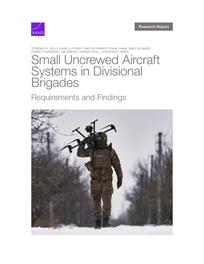Small Uncrewed Aircraft Systems in Divisional Brigades
Requirements and Findings
ResearchPublished Apr 8, 2025
This overview volume of a five-part series presents findings on how the U.S. Army can improve its training ecosystem for, and acquisition of, small uncrewed aircraft systems (SUAS). The authors developed these findings by examining requirements (and options for filling them), options for new approaches for acquiring and accounting for SUAS, and changes to the training ecosystem on Army installations needed to facilitate realistic training.
Requirements and Findings
ResearchPublished Apr 8, 2025

Small uncrewed aircraft systems (SUAS) present a major opportunity and challenge for the U.S. Army. Army units and organizations are actively experimenting with SUAS and developing new approaches for using them, providing insights into the Army's requirements for using SUAS at different organization levels. SUAS capabilities are rapidly evolving, which makes the task of fielding and maintaining cutting-edge SUAS-enabled forces more challenging.
Exploiting the many opportunities that SUAS present will require the Army to train as it will fight and overcome substantial force-integration challenges. To examine these issues, the XVIII Airborne Corps asked RAND researchers to identify options for the Army to select, field, and employ SUAS and to assess the implications of integrating additional SUAS for reconnaissance, fires, and other purposes below the division echelon.
The authors conducted interviews with Army and private-sector experts and reviewed applicable literature and databases related to SUAS. In this report, the authors identify materiel requirements for using SUAS effectively, develop case studies of such use, and demonstrate improvements to acquiring, training with, and managing SUAS.
This volume is the first of a five-part series and provides an overview of the study, including short summaries from the other volumes in this series.
The research described in this report was sponsored by sponsored by XVIII Airborne Corps and conducted by the Forces and Logistics Program within the RAND Arroyo Center.
This publication is part of the RAND research report series. Research reports present research findings and objective analysis that address the challenges facing the public and private sectors. All RAND research reports undergo rigorous peer review to ensure high standards for research quality and objectivity.
This document and trademark(s) contained herein are protected by law. This representation of RAND intellectual property is provided for noncommercial use only. Unauthorized posting of this publication online is prohibited; linking directly to this product page is encouraged. Permission is required from RAND to reproduce, or reuse in another form, any of its research documents for commercial purposes. For information on reprint and reuse permissions, please visit www.rand.org/pubs/permissions.
RAND is a nonprofit institution that helps improve policy and decisionmaking through research and analysis. RAND's publications do not necessarily reflect the opinions of its research clients and sponsors.